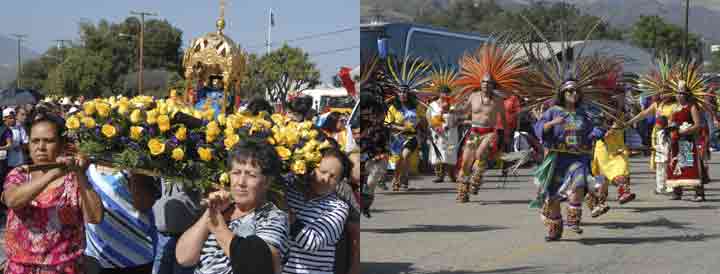
|
The doll of The Holy Child of Atocha (photo above left), nicknamed El Niño Azul because its usual garb is blue, depicts the Christ Child. The Catholic Church’s third-most cherished religious icon in Mexico, the Holy Child will be the focus of a celebratory Mass June 9 at Our Lady of Guadalupe Church. (Above right) The long procession included colorfully costumed Aztec and other dance troupes from throughout Southern California, equestrian groups featuring traditionally garbed vaqueros astride gorgeous horses, dancing Aztecas, and Friesians reflecting the joy of the crowd. |
El Santo Niño de Atocha: Arrival of icon in Santa Paula a joyous occasion
May 31, 2013
By Peggy Kelly
Santa Paula News
The large parade that drew thousands of joyous marchers Saturday was to celebrate El Santo Niño de Atocha, a wood-and-plaster doll dressed in often blue Renaissance clothing, a cherished religious icon again taking up residence at our Lady of Guadalupe Church.
The doll of The Holy Child of Atocha, nicknamed El Niño Azul because its usual garb is blue, depicts the Christ Child. The Catholic Church’s third-most cherished religious icon in Mexico, the Holy Child will be the focus of a celebratory Mass June 9 at Our Lady of Guadalupe Church.
This is the fifth consecutive year El Santo Niño has been on loan from its shrine in Plateros, Mexico. The sacred doll is enshrined in Santa Paula to allow visits by pilgrims who cannot travel to Plateros to visit the original that oversees the shrine. After a special June 9 Mass expected to draw thousands of worshipers to Our Lady of Guadalupe Church, El Santo Niño de Atocha will travel on to the Mid-West.
Tomas Gonzalez of Santa Paula was among the crowd that lined the parade route that started at Harding Park and ended at the North Oak Street church. In years past Gonzalez carried The Holy Child in the procession, and said he has even visited the shrine in Plateros.
“It’s something else, it’s awesome... there are 20 to 30 busloads a day” of pilgrims who visit the shrine, many hoping for the miracles the El Santo Niño de Atocha is famed for. The shrine in Plateros is the third most visited in Mexico; number one is Our Lady of Guadalupe in Mexico City, and number two is the shrine of Our Lady of San Juan in San Juan de Los Lagos.
Santa Paula Police were in charge of traffic control, including shutting down the streets along the parade route. “The crowd’s pretty big,” said Reserve Sgt. Dave Curran, who noted Citizens Patrol and the SPPD Explorers were helping with traffic and crowd control. “It’s a good event,” noted Curran before he drove off to clear the way for the procession.
Gonzalez said it was likely that at least 4,000 people were attending the parade: “They’ve been announcing it on the radio stations,” and a Spanish language television station van was on the scene to report on the event.
There had been a moment of doubt that The Holy Child would make the visit. The priest selected to accompany the icon from Mexico reportedly mislaid his passport, and Our Lady of Guadalupe’s own Father Charles Lueras flew to Mexico City to meet the icon and accompany it to Santa Paula.
Gonzalez noted there are two El Santo Niño de Atocha statues: “One stays in Mexico and the other,” he noted with a grin, “has the Green Card,” and travels to the United States.
The long procession included colorfully costumed Aztec and other dance troupes from throughout Southern California, equestrian groups featuring traditionally garbed vaqueros astride gorgeous horses, dancing Aztecas, and Friesians reflecting the joy of the crowd. Bands played lively tunes as people cheered the return of El Santo Niño de Atocha to Santa Paula, The Holy Child distinctly characterized by a basket he carries, along with a staff, drinking gourd, and a cape with the shell symbol of a pilgrimage to Saint James.
Gonzalez noted that many make elaborate dresses for The Holy Child will be bring to the church daily for the doll to be changed into. Visitors from throughout the nation are expected to come to Santa Paula to see The Holy Child.
The history of the icon dates back to the 13th century, when the now lost town of Atocha, Spain was conquered by invading forces. Many Christians were taken prisoners and were often denied food by their captors. Only children under 12 years old were permitted to bring the prisoners food, and the women prayed before the statue of Our Lady of Atocha at a nearby parish - a title under the Blessed Virgin Mary - to ask her son Jesus Christ for aid and help.
Soon it was reported that an unknown younger boy dressed in pilgrim’s clothing had begun to bring food to childless prisoners. When the women heard of the child, they returned to the church to thank the Virgin for her efforts, and noticed that the shoes worn by the Infant Jesus statue held by Our Lady of Atocha were tattered and dusty. No matter how often they were changed, the shoes continued to show signs of wear and the people of Atocha interpreted this as a sign that the infant Jesus went out every night to help those in need, which later developed into a devotional Roman Catholic practice.
In Mexico, The Holy Child was credited with helping to save those trapped in a silver mine explosion, the statue’s dirty and tattered clothing and shoes used as proof the El Santo de Nino was the one who first offered water and then led the men to safety. Thereafter, The Holy Child was declared the protector of miners and placed in a special glass box for all to see and celebrate.



